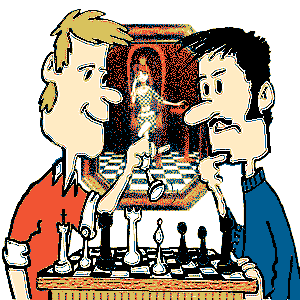Learn Specific Chess Endgame Showdowns

You can also have a specific type of chess endgame based on the remaining material in addition to well known key positions. Some with pawns remaining, some not.
Many endgames require themes and techniques distilled by masters over decades designed particularly for the endgame in question.
In many cases the path to victory is so well hidden that it is not easy for the club player to find it. But you can benefit from the work of chess geniuses by using their methods to win these specific endgames.
i. Rook vs Bishop
































































Chess Endgame - Rook vs Bishop
The King and Rook are playing for the win and can get it. They must first deal with the pesky Bishop. This can be done by combining mating threats with attacks on the Bishop.
The trick is to drive the King to the correct corner and then force the Bishop to block a check on the home rank. After that you just waste a tempo and the King must abandon the Bishop.
There is a right corner and a wrong corner. Wrong corner means a draw. Once you know where to drive the King and how to make the double threats, this endgame is a snap. It's just a case of hammering off the moves.
ii. Rook vs Knight
































































Chess Endgame - Rook vs Knight
Here again the Rook and King will be working to a formula to trap the Knight. The weaker side will be trying to keep his King and Knight together.
Rook and King will combine to force the defending two to the edge of the board before scheming to prize them apart. Great care must be taken not to fall victim to a Knight fork. The Knight is then pursued.
Techniques that have been worked out many moons ago will be applied to force the capture of the Knight and the King will be checkmated soon after.
iii. Knight vs Pawn
































































Chess Endgame - Knight vs pawn
If the Knight can get in front of the pawn he can stop it from promoting. The position of the two Kings is not relevant for a central pawn.
The Knight can dance away from the King no matter which side he approaches. The queening square is always covered and the Knight will happily sacrifice himself for the pawn as he is only playing for the draw.
Defense can be more problematic with a Rook pawn as the Knight cannot escape the King's intentions. In this case the defending King had better not be too far away.
iv. Queen vs Pawn
































































Chess Endgame - Queen vs Pawn
This usually ends in victory for the Queen. However, if the pawn reaches the seventh rank it has possibilities of forcing a draw. A pawn on the sixth rank can also sometimes make a draw.
Queen and pawn situations usually arise after a pawn race for promotion. White can win in the position in the diagram. The Queen can stall indefinitely by continually forcing the Black King in front of his pawn.
This allows the distant White King to eventually make contact. After many moves the King and Queen can together forcibly capture the pawn.
v. Rook vs Pawn
































































Chess Endgame - Rook vs pawn
The main factor here hinges on the position of the Kings in relation to the pawn. The King and Rook must be able to both attack the pawn before it promotes.
In the diagram White need only play Rh6 followed by Rc6 and the pawn is a goner. But it's not always as easy as that.
Sometimes it can be very tricky to get both attackers on the pawn in time. If this is not achieved then the Rook will have to be sacrificed and the game will end in a draw.
vi. Same Colored Bishops
































































Chess Endgame - Bishops of Same Color
Same color Bishops is always good in the endgame for the side with the pawn. The attacking side can drive off the defending Bishop and then push his pawn to promotion.
There are some defensive resources in this endgame and a skilled opponent will use them on you. But with good technique all of these attempted parries can be thwarted. This is a won endgame.
Just take control of the shortest diagonal with the queening square on it. Evict the defending Bishop and the rest is easy.
vii. Opposite Colored Bishops
































































Chess Endgame - Bishop of Opposite Colors
Opposite color Bishops on the other hand is good for the defense. The problem for the attacking side is the Bishop cannot engage his counterpart and can't drive him away from the defense of key squares on the pawns path to accession.
In the diagram Black intends to sacrifice his Bishop for one of the pawns as soon as they enter the long diagonal. The King will pick up the other earning the draw. If White plays h7 then g7 belongs to the Black King.
White's Bishop can't drive the Black Bishop off this key diagonal. Neither can he support the White pawns as they enter it. The White Bishop is basically irrelevant.
White's Bishop can't drive the Black Bishop off this key diagonal. Neither can he support the White pawns as they enter it. The White Bishop is basically irrelevant.
At this point White should just agree to the draw as Black can simply move his Bishop back and forth on the long diagonal. As soon as White loses patience and starts pushing his pawns Black will carry out his plan.
viii. Bishop vs Knight
































































Chess Endgame - Bishop vs Knight
The Bishop and Knight and are of similar value in the game of chess. As their movements are quite different, you could say their fighting styles are quite different. So in different situations, games of a different nature determine which is stronger.
The Knight is a short range piece whereas the Bishop is a long range piece. Therefore Knights tend to be stronger than Bishops in closed situations. Bishops on the other hand are stronger than Knights in open games.
Knights prefer when all pawns are on the same wing. This negates the Bishop's advantage over him. The Bishop does much better when there are pawns on both wings.
ix. Rook vs Rook
































































Chess Endgame - Rook Endgames
Rook and pawn endgames are more common finishes than any other. They are also very tricky and extreme care should be taken as error can prove fatal.
The two most studied rook and pawn scenarios are the Lucena Position and the Philidor Position. A knowledge of these two are more than useful and could well be called upon some day if you find yourself in such a situation.
These endgames favor the active Rook over the passive Rook. It is also a good idea to tie down the enemy King if you can. Active pieces always come out on top.
x. Knight vs Knight
































































Chess Endgame - Knight Endgames
They call Knight endgames pawn endgames because most of the same rules apply. There is some potential for tactics though. A well timed Knight sacrifice can topple a once solid pawn chain and lead to a breakthrough.
You should also aim to create threats with your Knight. This may force his counterpart to defend some pawns from a passive location. If you can centralize your King at the same time you may be able to take over the game.
Basically the same ideas are foremost as in King and pawn endgames: centralize your forces, attack weak points and capitalize on any tactical opportunities. If the possibility of exchanging the Knights presents itself make sure the resulting pawn endgame is in your favor.
xi. Queen vs Three Minor Pieces
































































Groningen vs Schwarz - 1913
This endgame is one of the most attractive imbalances in chess. In terms of material, the three minor pieces are considered to be equal to the Queen.
So the nature of this endgame will depend on the terrain (pawn structures). But mostly it will come down to whether the player with the three minor pieces has the skills to get the most out them.
In the right hands they can be a fearsome team. You need to get them active and harmonious. Posted on nice squares where they can inflict pressure on the enemy camp.
In the right hands they can be a fearsome team. You need to get them active and harmonious. Posted on nice squares where they can inflict pressure on the enemy camp.
They need to be supporting each other and working together with purpose. They will command so many key squares from the right posts that they can give the Queen a torrid time.
xii. Queen vs Rook
































































Queen vs Rook
Queen vs Rook is a won endgame for the Queen but it is far from easy. It is an endgame that must be taken in stages. The main problem is both King and Queen are needed to drive the weaker two toward their demise.
The Rook can impede the King's progress by controlling key ranks or files, not allowing the King to pass. The stronger two must embark on a series of long maneuvers to counteract the defense. They are working to force a series of known positions.
From these positions, they can play forcing moves which will eventually force the King and Rook apart. The Rook will be picked up and checkmate is in the post.
Moving On

Theoretical knowledge of positions with certain material imbalances can win you a fair few games. Especially when added to forensic knowledge of key positions.
There is a third element involved in polished endgame play and it may be the most integral. These first two are based around learned disciplines. They are set plays straight off the training ground.
The last element is based on advancing your internal instincts as a chess player. Working on your strategic knowledge of positional ideas. It's time to develop your conceptual understanding of the game. We're talking about endgame themes.

